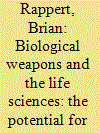| Srl | Item |
| 1 |
ID:
059405


|
|
|
| 2 |
ID:
051230


|
|
|
|
|
| Publication |
London, Frank Cass, 2003.
|
| Description |
xiv, 286p.
|
| Standard Number |
0714683604
|
|
|
|
|
|
|
|
|
|
|
|
Copies: C:1/I:0,R:0,Q:0
Circulation
| Accession# | Call# | Current Location | Status | Policy | Location |
| 048232 | 355.82/RAP 048232 | Main | On Shelf | General | |
|
|
|
|
| 3 |
ID:
089072


|
|
|
|
|
| Publication |
2009.
|
| Summary/Abstract |
By the end of 2008, ninety-five states had signed the Convention on Cluster Munitions, which bans the development, production, acquisition, stockpiling, and transfer of cluster munitions; imposes significant obligations for the clearance of unexploded cluster munition remnants; and elaborates novel requirements for so-called victim assistance. This article examines this agreement and the process that lead up to it in terms of the precedents it sets for future arguments about weapon technologies and the regulation of armed conflict. Particularly noteworthy was the process for determining what counts as a "cluster munition" under the convention. The definition structure transformed the argument from considerations of what types should be prohibited to demanding justifications for what should be allowed. In other words, rather than the burden of proof resting with those seeking a ban, the presumption became that exclusions from prohibition had to be argued in by proponents of specific submunition-based weapons. This approach contrasts with the manner in which the burden of proof regarding cluster munitions has been handled in international humanitarian law.
|
|
|
|
|
|
|
|
|
|
|
|
|
|
|
|